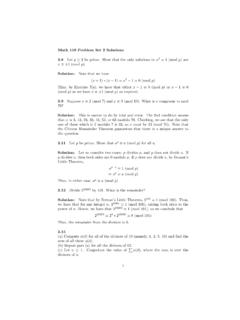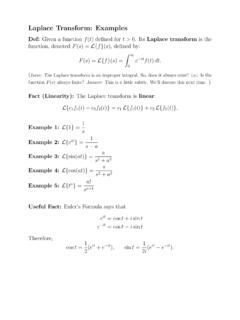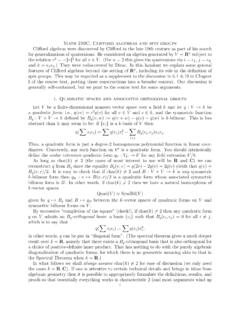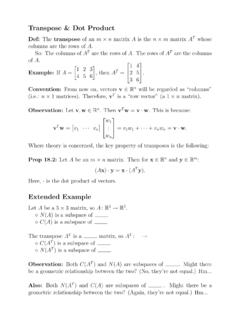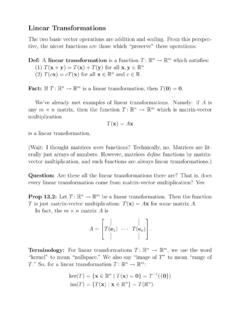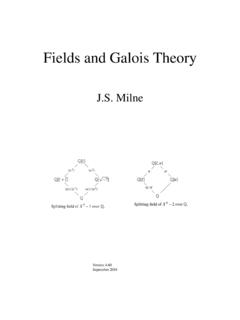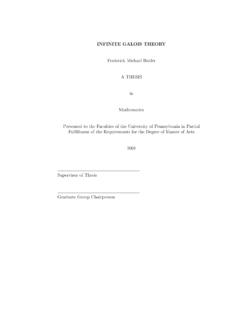Transcription of Outline of Galois Theory Development - Stanford University
1 Outline of Galois Theory Development1. Field extensionF Eas vector space overF.|E:F|equals dimension as vector space. IfF K Ethen|E:F|=|E:K||K:F|.2. Elementa Eis algebraic overFif and only if|F(a) :F|is finite. Minimum polynomialf(X) F[X]for algebraica (X) is irreducible,F(a) =F[a] =F[X]/(f(X)),|F[a] :F|= degf(X), a basisis{1,a,a2,..,ad 1}, whered= degf(X). The set of elementsa Ewhich are algebraic overFis asubfield Existence of Splitting Fields for a polynomial or family of polynomialsF F[X]. Existence ofAlgebraic Closure. Characterizations of Algebraic Closure: A fieldEis algebraically closed if everynon-constant polynomial inE[X] factors as a product of linear polynomials. (Equivalently, every non-constant polynomial inE[X] has a root inE.)
2 A fieldEis an algebraic closure of a subfieldFifEisalgebraic overFand every non-constant polynomial inF[X] factors as a product of linear polynomialsinE[X]. Such anEis algebraically Uniqueness of Splitting LEMMA:h:F L extends toh :F[a] L if and only ifhf(X) has roots inL , wheref(X)is the minimum polynomial foraoverFandhf(X) is the image off(X) under the mapF[X] L [X]induced byh. The number of distinct extensions ofh,h :F[a] L , equals the number of distinctroots ofhf(X) inL , andh is determined by the valueh (a) =a , wherea is a root ofhf(X) inL .CONSEQUENCE: IfF Lis a splitting field ofF F[X],h:F F a field homomorphism, andF L an extension which contains a splitting field ofhF F [X], thenhextends toh :L L .In particular, any two splitting fields ofFare isomorphic COROLLARY OF MAIN LEMMA: If|E:F|is finite, the number of distinct extensionsh :E Lofh:F Lis always less than or equal to|E:F|.
3 6. Normal (Algebraic) ExtensionsF E. Three characterizations:(i)Eis a splitting field of a family of polynomials overF.(ii) Ifh:E Fis any embedding into the algebraic closure ofFwithh= id onF, thenh(E) =E.(WLOG,F E F.)(iii) If an irreducible polynomialg(X) F[X] has a root inEtheng(X) factors into a product oflinear factors inE[X]. That is, all roots ofg(X) in Fare The derivativef (X) and algebraic properties. Especially gcd(f,f ) = 1 if and only iff(X) has nomultiple roots. Consequently, if char(F) = 0 or ifFis a finite field then every irreducible polynomialof degreedinF[X] hasddistinct roots in the algebraic closure Separable (Algebraic) ExtensionsF E. Three characterizations:(i) Every elementa Eis the root of a polynomial with no multiple roots.
4 That is, every elementofEis separable overF.(ii)Eis generated overFby separable elements.(iii) IfE Eand|E :F|is finite, then|E :F|equals the number of distinct embeddingsh :E Fwithh = id onF. (So if|E:F|is finite, then|E:F|equals the number of distinct embeddingsE FoverF).NOTE: It follows from these considerations, especially (??), that givenF K E,K/FandE/Kboth separable impliesE/Fseparable. Also, the set of elements in anyEwhich are separable overFforms a subfield Theorem of the Primitive Element for finite separable extensionsE/F. Namely,E=F[a], for somea E. There are many proofs. , start withF[u,v], then look at elementsa=u+cvwithc (X) andg(X) are the minimal polynomials foruandvover F, choosecso thatf(a cX) andg(X) have exactly one common root, namelyv.
5 Then gcd(f(a cX),g(X)) F[a][X] must beX v,hencevis inF[a], so alsouis inF[a], andF[u,v] =F[a]. (This proof works for infiniteF. IfFisfinite so isE, andE is a cyclic multiplicative group, soE=F[a] is clear.)110. DefineE/Fto be a Galois extension if and only ifEis separable AND normal over F. (This is the right definition, because the conditions separable and normal are easily understood in terms of individualgenerators ofEoverFand the roots of their minimal polynomials.)11. COROLLARY: A finite extensionE/Fis Galois if and only if|E:F|equals the number of automor-phismsg:E Ewithg= id onF. (The proof just combines characterization (??) of Normal withcharacterization (??) of Separable.)12. Define the Galois Group Gal(E/F) to be the group of automorphismsg:E Ewhich fix all elementsofF.
6 For finite Galois extensions,|Gal(E/F)|=|E:F|, by item Iff(X) is a separable, irreducible polynomial of degreen, then the Galois group of its splitting field isa transitive subgroup of the symmetric groupSnof all permutations of the roots off(X). The orderof the group is divisible Define the Fundamental Correspondences{H G} {intermediate fieldsLofE/F},whereG= Gal(E/F).H7 EH, the subfield ofEfixed by all elements Gal(E/L), thesubgroup ofGfixing all elements State and prove the Fundamental Theorem for Finite Galois directionL7 Gal(E/L) =H7 EH=Lis easy , and just uses the definitions and the fact from12 that|Gal(E/L)|=|E:L|. The directionH7 EH=L7 Gal(E/L) =Hrequires more. Thesticking point is why is|E:EH| |H|? But ifE=L[a] then the product (X ha),h H, is apolynomial with coefficients inEH=Lwhich hasaas a root and has degree|H|.
7 So|L[a] :L| |H|.By the Theorem of the Primitive Element, the assumptionE=L[a] is justified here. Ifg:E Eis an automorphism overFandL Eis an intermediate field, corresponding to subgroupH G,then it is a trivial group action fact that the subgroup ofGcorresponding to the fieldgL Eis theconjugate subgroupgHg 1ofH. SoHis normal inGif and only ifLis normal overF. In this case,Gal(L/F) =G/Hfollows easily, since there is a mapG Gal(L/F), which is onto and has Two miscellaneous results:(i) An algebraic extensionF Eis primitive, that is,E=F[a], if and only if there are only finitelymany intermediate fieldsL, withF L E.(ii) IfHis a finite group of automorphisms of a fieldEandEHis the fixed field, then the extensionE/EHis finite, normal, separable, and|E:EH|=|H|.
8 (Result (??) is closely related to the trickier part of the Fundamental Theorem in 15. In that situa-tion though, one knewE/EHwas finite, normal, separable, because one started with a finite GaloisextensionE/F. But, here, all this must be proved.)17. Two results about composite extensions:(i) IfK/Fis a finite Galois extension andL/Fis any extension, thenKLis Galois overLwithGal(KL/L) = Gal(K/K L) Gal(K/F).(ii) IfK/FandL/Fare two finite Galois extensions thenKL/Fis Galois andGal(KL/F) Gal(K/F) Gal(L/F),specifically, the subgroup{(u,v)|u:K Kandv:L Lwithu=vonK L}.(In part (??), interpretKLandK Las subfields of L, the algebraic closure ofL. Specifically, Lcontains a unique isomorphic copy ofK, sinceKis the splitting field of some polynomial inF[X].)
9 Inpart (??), interpret bothKandLas subfields of F.)218. Artin s proof thatC=R[i] is algebraically closed. First, every element ofChas square roots, soChas no quadratic extensions. SupposeE/Cis some finite algebraic extension, which WLOG can beassumed normal overR. If|E:R|is divisble by an odd prime, the fixed field of a Sylow 2-subgroup ofGal(E/R) would have odd degree overR. Any element of this field would have minimal polynomial overRof odd degree. But every odd degree polynomial overRhas a root inR, hence can t be ,|E:C|= 2n, for somen. But then ifn >0, Gal(E/C) would contain a normal subgroup ofindex 2, corresponding to a proper quadratic extension EXAMPLE: Roots of roots ofXn 1 = 0 that lie in a field extensionEofFform a multiplicative subgroup ofE, henceform a cyclic group.
10 If char(F) =pdoes not dividen, there arenroots in the splitting field. Thus, theGalois group is a subgroup of Aut(Z/nZ), hence is abelian of order dividing (n) =|(Z/nZ) |. Thesplitting field is generated overFby any primitiventh root of 1, sayz, and a Galois automorphism isdetermined by the image ofz, which is some powerzjwith (n,j) = 1. The automorphism must fixF,so perhaps only a proper subgroup of suchjin (Z/nZ) give Galois group elements. InZ[X], thereis a factorizationXn 1 = dFd(X), wheredruns over all divisors ofn, and theFd(X) are definedinductively. The roots ofFn(X) are precisely the primitiventh roots of 1, so degFn(X) = (n). It isproved that allFn(X) are irreducible inQ[X], hence the splitting field ofXn 1 overQhas degree (n) and Galois group Aut(Z/nZ) = (Z/nZ).

